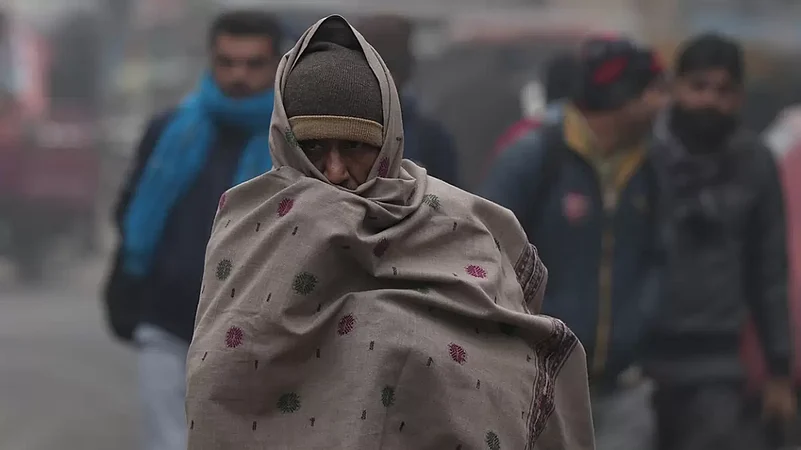Large parts of north India reeled under numbing cold on Tuesday with the mercury remaining below the freezing point at most places in Jammu and Kashmir, while dense fog in the early hours of the morning hit road and rail traffic movement.
Cold Wave Conditions Persist In Most Parts Of North India
According to the weather office, 'very dense fog' is when visibility is between 0 and 50 metres, between 51 and 200 metres is 'dense', between 201 and 500 metres 'moderate', and between 501 and 1,000 metres 'shallow'.

The mercury rose a few notches in Delhi, bringing its residents some respite from the cold.?In Jammu and Kashmir, Srinagar recorded a low of 1.8 degrees Celsius on Monday night, up from 0.9 degrees the night before, officials said. Qazigund, the gateway to the Valley, registered a minimum temperature of minus 0.8 degrees Celsius, while Kokernag in south Kashmir recorded a low of minus 3.6 degrees, they said.
The mercury settled at 2.7 degrees Celsius in Kupwara and minus 3.2 degrees Celsius in Pahalgam.?It remained below the 10-degree mark across weather stations in the Valley. According to the meteorological office, moderate snowfall is very likely at many places in the higher reaches.
The plains in the Valley are expected to receive light to moderate snow. Light snowfall, with rains in the plains of Jammu, is likely at many places in Jammu and Kashmir, the weather office said. Kashmir is currently under the grip of 'Chillai Kalan', the 40-day harshest winter period when the chances of snowfall are the maximum.
'Chillai Kalan' begins on December 21 and ends on January 30. The cold wave continues even after that with a 20-day 'Chillai Khurd' (small cold) and a 10-day 'Chillai Bachha' (baby cold) following it.?Cold wave conditions abated in Delhi due to a fresh western disturbance affecting northwest India, even as a dense layer of fog lowered visibility to just 50 metres, affecting road and rail traffic movement.
The Safdarjung observatory, Delhi's primary weather station, recorded a minimum temperature of 6.4 degrees Celsius as against?3.8 degrees Celsius on Monday. The weather stations at Lodhi Road and Palam logged a minimum temperature of 6.4 degrees Celsius and 7.5 degrees Celsius. An official of the India Meteorological Department (IMD) said the Palam observatory near the Indira Gandhi International Airport recorded a visibility level of 50 metres.
Thirty-nine trains were delayed by an hour to five-and-a-half hours due to the foggy weather, a Northern Railways spokesperson said. Satellite images showed a dense layer of fog persisting over vast swathes of north India, extending from Punjab to Bihar across Haryana, Delhi and Uttar Pradesh. According to the weather office, 'very dense fog' is when visibility is between 0 and 50 metres, between 51 and 200 metres is 'dense', between 201 and 500 metres 'moderate', and between 501 and 1,000 metres 'shallow'.
Chilly weather in Delhi since the start of January strained power grids and posed challenges to homeless people. It also prompted the Delhi government to extend winter vacations in schools till January 15. Delhi logged a minimum temperature of 3.8 degrees Celsius on Monday, 1.9 degrees Celsius on Sunday, 2.2 degrees Celsius on Saturday, 4 degrees Celsius on Friday, 3 degrees Celsius on Thursday and 4.4 degrees Celsius on Wednesday.
Meteorologists attribute the long spell of intense cold to a long gap between two western disturbances, which meant frosty winds from the snow-clad mountains blew in for a longer-than-usual period. Biting cold conditions persisted in most parts of Punjab and Haryana, with Bathinda being the coldest place in the region with a minimum temperature of 2.4 degrees Celsius.
Amritsar recorded a low of 9.2 degrees Celsius and Ludhiana 8.2 degrees Celsius, according to a meteorological department report. The minimum temperature settled at 7.9 degrees Celsius in Patiala, 10.4 degrees Celsius in Pathankot, 6 degrees Celsius in Faridkot and 6.5 degrees Celsius in Gurdaspur
In Haryana, Bhiwani recorded a minimum temperature of 3.8 degrees Celsius. The mercury settled at a low of 8.2 degrees Celsius in Ambala, 4.3 degrees Celsius in Hisar, 8.5 degrees Celsius in Karnal, 5 degrees Celsius in Narnaul, 7.2 degrees Celsius in Rohtak and 4 degrees Celsius in Sirsa. Chandigarh, the joint capital of Punjab and Haryana, recorded a minimum temperature of 7.8 degrees Celsius.
- Previous Story
 Marital Rape 'A Social Issue Not Legal', Centre Files Affidavit With SC Against Criminalisation
Marital Rape 'A Social Issue Not Legal', Centre Files Affidavit With SC Against Criminalisation - Next Story
























